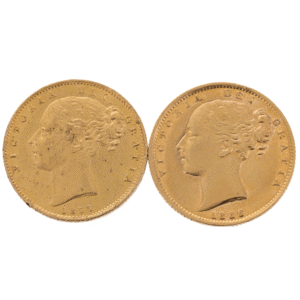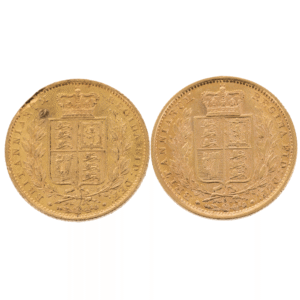The Queen Victoria Young Head Shield Sovereign stands as one of the most historically significant gold coins in British numismatic history. Introduced in 1838 following Victoria’s accession to the throne, these elegant gold pieces represent the first sovereigns of what would become the longest-reigning British monarch until the modern era. Spanning nearly three decades of production, these coins witnessed Britain’s transformation into the world’s preeminent industrial and imperial power.
When these sovereigns first appeared, Victoria was a young queen of just 18 years, ascending to the throne of a nation on the cusp of unprecedented transformation. The period from 1838 to 1874 (when the Young Head Shield reverse design was produced) witnessed:
- The height of the Industrial Revolution transforming Britain’s economy and society
- The Great Exhibition of 1851 showcasing Britain’s industrial might
- Rapid colonial expansion across Africa, Asia, and the Pacific
- The establishment of the British Raj in India
- The gold rushes in California and Australia that dramatically increased global gold supplies
These sovereigns circulated during this pivotal period when Britain established itself as the world’s leading economic, industrial, and imperial power – a position reflected in the growing global acceptance of British gold coinage as a standard of value.
The obverse features William Wyon’s iconic “Young Head” portrait of Queen Victoria facing left, widely considered one of the most beautiful coin portraits ever created. This classically-inspired design shows Victoria with her hair in a simple bun secured by a ribbon, giving her a dignified yet youthful appearance.
The portrait is surrounded by the legend “VICTORIA DEI GRATIA” (Victoria by the Grace of God) with the date below. Wyon’s initials “W.W.” appear on the truncation of the neck on most issues.
The reverse displays the quartered shield of the Royal Arms, crowned and encircled by a wreath. The shield depicts:
- First and fourth quarters: Three lions passant guardant (England)
- Second quarter: Lion rampant (Scotland)
- Third quarter: Harp (Ireland)
Surrounding this design is the inscription “BRITANNIARUM REGINA FID DEF” (Queen of the Britains, Defender of the Faith). This shield design provides a direct connection to Britain’s royal heritage and sovereignty.
FAQs
Queen Victoria’s long reign (1837-1901) resulted in three distinct portrait designs on sovereigns:
- Young Head (1838-1887): Used with both shield reverse (1838-1874) and St. George reverse (1871-1887)
- Jubilee Head (1887-1893): Commemorating her Golden Jubilee, featuring a crowned portrait
- Old Head/Veiled Head (1893-1901): Showing the elderly queen with a widow’s veil
The change back to Pistrucci’s St. George and dragon design (which had been used on George III and early George IV sovereigns) was part of a broader effort to create a more unified and recognisable British coinage design. The artistic merits of Pistrucci’s classic design were also widely appreciated, and it has since become the standard sovereign reverse design, used with few exceptions to the present day.
The obverse of the coin features a young effigy of Queen Victoria wearing a laurel wreath, while the reverse displays a shield motif representing the strength and protection of the British Empire. The design is both intricate and elegant.
These coins were minted during the first half of Queen Victoria’s reign, from 1838 to 1887. They reflect the opulence and power of the British Empire during that period, making them significant historical artifacts.

